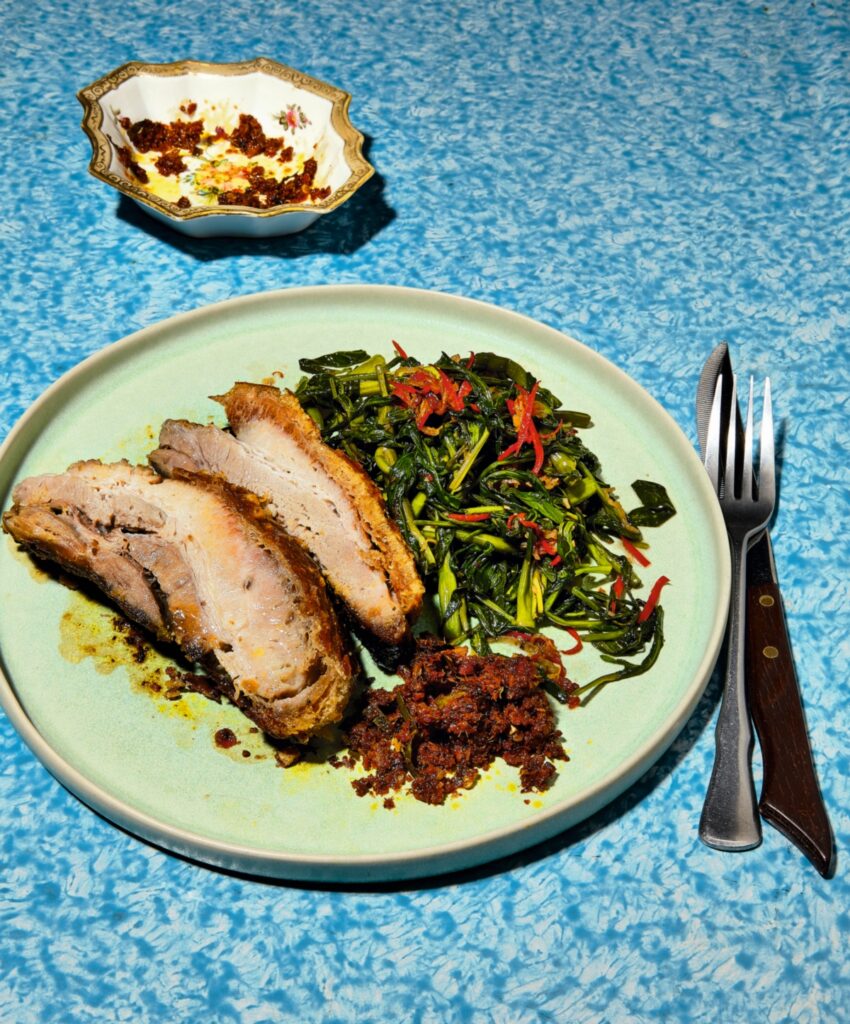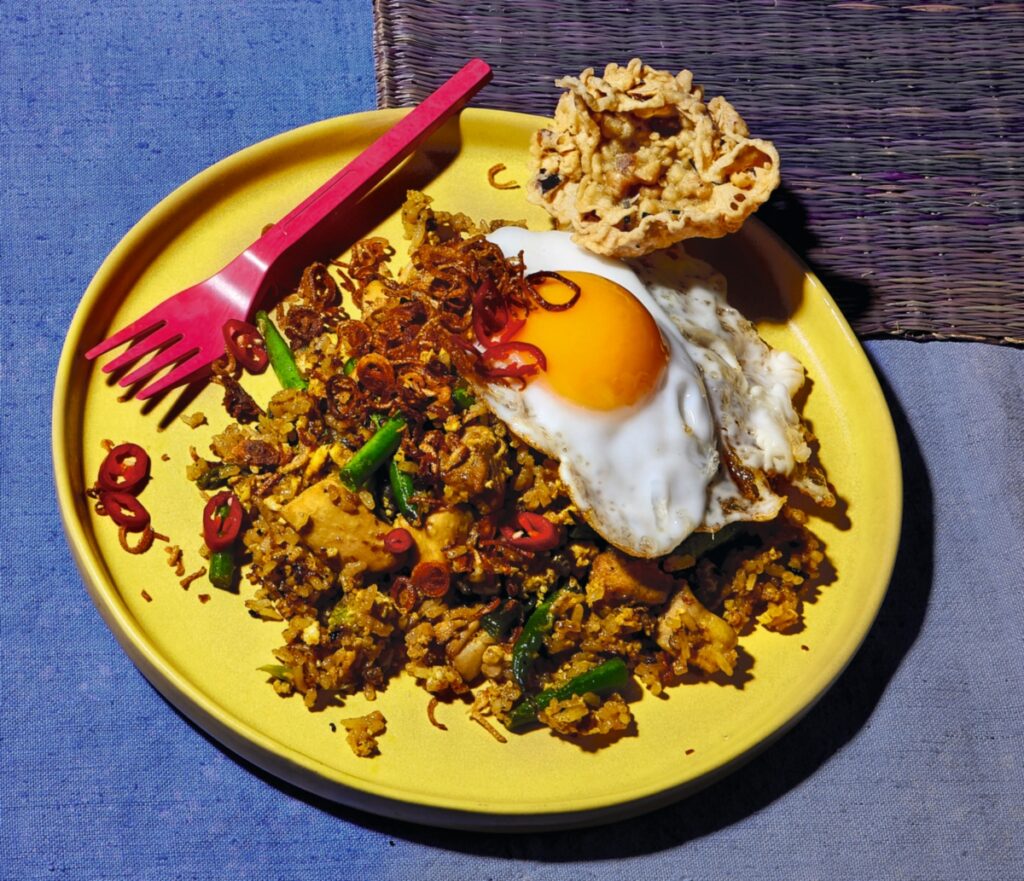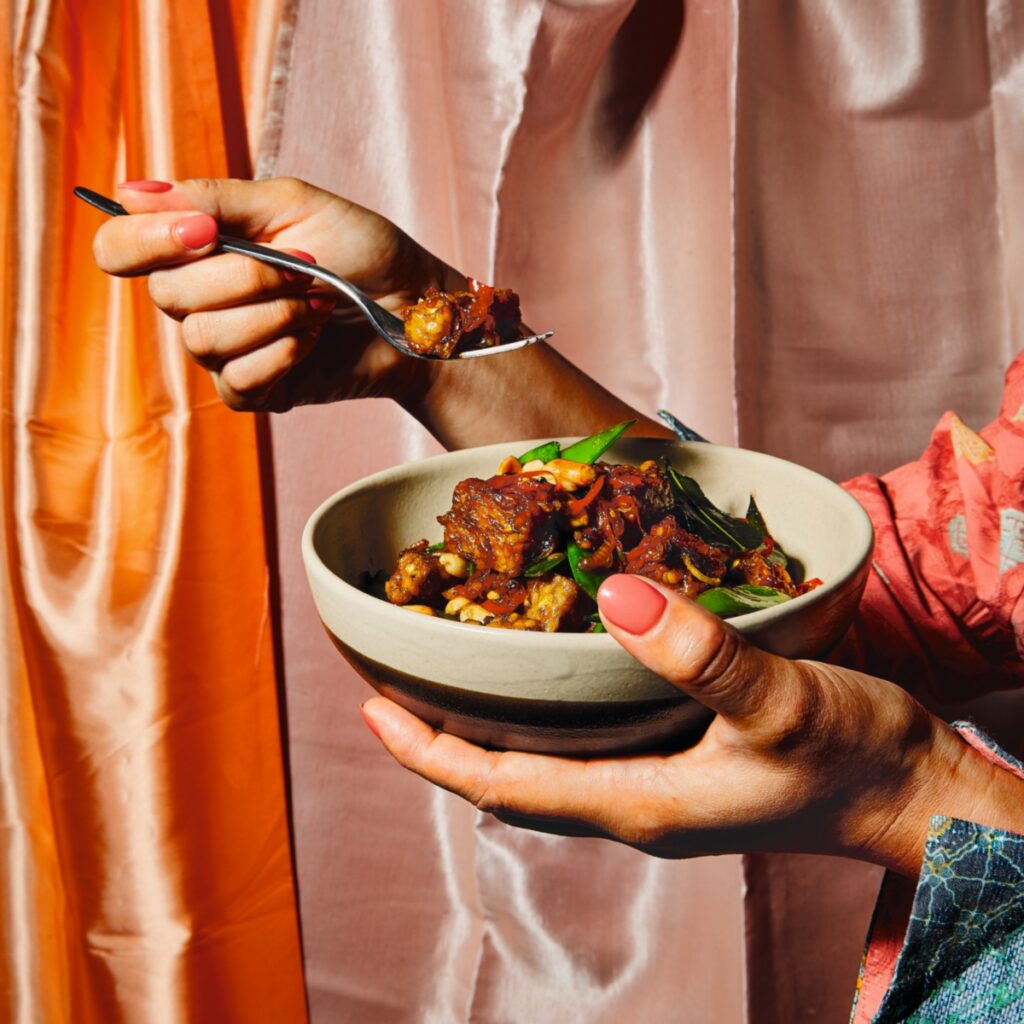Lara Lee has an Australian mother and an Indonesian father. She grew up in Australia and now lives in London, England. Lee’s memories of Indonesia were primarily those of her grandmother, who joined the family in Australia from her home on the island of Timor. It wasn’t until Lee became a professional chef that she developed an interest in understanding her culinary roots. That journey, in stories, photographs and recipes, is told in the pages of Coconut & Sambal. It is primarily a cookbook but one greatly enriched by context – personal, geographic and cultural.
I admit to a bias in reviewing this title. I lived in Indonesia a journalist for 11 years. For nine of those a mother and daughter team lived with me, cooking for me and taking care of the house. Every day when I wasn’t travelling, breakfast, lunch and dinner were laid out for me, prepared from scratch, with ingredients purchased at the local market or from street vendors who passed by the house pushing wheeled carts, making various banging, tinkling and tok-tok sounds to signify their presence. By rough calculation, I have consumed something like 12,000 Indonesian meals.
Given my long association with and deep love of Indonesian cuisine, I fretted that Lee’s cookbook, based on a handful of research trips, would be a disappointment.
But Lee is very well connected. In London she was befriended by Sri Owen, arguably Indonesia’s most illustrious culinary expert and the first to write about its cuisine in English. Now in her eighties, Owen was willing to share her knowledge and cook alongside Lee as the younger chef sought to learn about her father’s culture. When Lee travelled to Indonesia to research recipes, doors were opened to her by a who’s who of food personalities ready to provide tips and share their expertise. That collective erudition is evident throughout the pages of Coconut & Sambal.
The book is divided into chapters: Savoury Snacks; Soups & Rice; Vegetables, Tofu & Tempeh; Fish & Seafood; Poultry & Eggs; Meat; Sambal; Sweets and Basic Recipes. Additional sections provide an overview of Indonesian cuisine, ingredients, meal planning and menus. A Dietary List, classifying recipes as Vegetarian, Vegan, Dairy Free or Gluten Free, is a thoughtful addition given the current trend for personalized eating regimes.
Lee writes with an emotional directness that conveys her delight in discovering a feeling of connection to the people of Indonesia. At the same time, she has a chef’s curiosity that requires a more than superficial understanding of ingredients, technique and recipe provenance. As we read the chapter introductions and recipe headnotes, our confidence in the author builds. By the time we get to cooking, there is already a feeling that we will succeed, because we have a trustworthy teacher. By my reckoning, this is a mark of a good cookbook.
And so to cooking.
Smoky, charcoal-grilled corn (Jagung Bakar) is a favourite roadside snack in Indonesia. I baulked at Lee’s instruction to grill the corn with a kitchen blowtorch but the method works a treat and is an easy way to achieve a char if you don’t possess, or don’t want to fire up, a barbecue. Lee lives in an apartment, where cooking over charcoal is presumably a challenge. She adapts many recipes that would typically be cooked over live fire for the oven or broiler. After tasting the corn, and two other dishes (chicken satay and Balinese pork ribs) that are cooked over coals in Indonesia, my initial doubts gave way to admiration for her ingenuity.

Travel in Bali and you will encounter the savoury aroma of pork grilling by the side of the road at almost every turn. Cooks fanning the coals with woven mats generate clouds of scented smoke that set passersby salivating. Cooked in the oven and finished under the broiler, Lee’s version of Iga Babi Bali (Balinese Sticky Glazed Pork Ribs) was another surprisingly successful departure from traditional technique.
Nasi Goreng (Fried Rice) and Sate Ayam (chicken satay) are two Indonesian dishes well known to the rest of the world. Lee’s fried rice, with layers of flavour from aromatics, soy and fish sauce, is more nuanced than many versions of this staple and does away with the need for the (odiferous and hard to find) fermented shrimp paste called terasi.

With its flavourful marinade and piquant sauce, Lee’s Sate Ayam Madura lacks nothing when cooked under the broiler instead of over live coals. Indonesian peanut sauce is darker and more deeply flavoured than the Thai-style – often made with peanut butter — that seems to dominate the internet. Taking the time to follow Lee’s directions to roast and grind peanuts results in a more complex sauce with an authentic flavour.
Lee also offers alternative methods for dishes that typically involve deep frying. Most Indonesian snack foods (including spring rolls, crackers, fritters and dumplings) are deep fried, which renders them undeniably delicious but not necessarily healthy. Lee gives directions for shallow frying and baking where these methods will produce a satisfactory result. I was delighted to find that I could make a creditable batch of Perkedel Kentang (potato fritters seasoned with spices) without the hassle of deep frying.
There’s no alternative to deep frying if you want to taste rempeyek. These crispy riceflour and peanut crackers, flavoured with lime leaf and spices, are the perfect accompaniment to a cold beer. In Indonesia they’re displayed in large plastic jars in the little lean-to restaurants called warungs and they are impossible to resist. I made a half batch, and promptly ate the lot.
Sambals – pungent condiments, often but not always chilli-hot, and either raw or cooked, are an essential component of Indonesian meals, helping to balance flavours and textures. Lee suggest a sambal pairing with many of her recipes and while the dishes can stand on their own, taking the extra time to prepare an accompanying sambal pays dividends at the table.
The chapter on Vegetables, Tofu and Tempeh yielded more success. Lee’s Lawar Buncis Bali, made with green beans, edamame and mangetout, captures all the crunch and flavour of the classic Balinese salad despite the substitution of dessicated coconut for fresh. A little bowl of the fresh Balinese condiment Sambal Matah on the side allowed for adding heat and aromatic pungency to taste.
Jamur Sayur Kecap (Soy Mushrooms and Pak Choy), lightly dressed with soy sauce and vinegar, is a simple but flavoursome side dish that pairs as well with a plain piece of chicken or fish, as with more complicated dishes. Stir Fried Vegetable Cap Cay, a Chinese-influenced dish of mixed vegetables in a light sauce thickened with cornstarch, in Lee’s hands is nothing like the gelatinous offerings encountered so often in the west.

Tempe Manis is an excellent recipe to introduce cooks who are unfamiliar with this nutritious fermented soybean cake. Tempeh originated in Indonesia and Lee’s method of braising it in sweet soy sauce is a classic treatment that preserves its unique texture and taste, while coating it in a moreish, sticky glaze.
Overall, I was deeply impressed by Coconut & Sambal, for Lee’s concise but intelligent survey of a complex and regionally diversified cuisine. And, for those of us who don’t have access to the particular ingredients and techniques available to native cooks, for her excellent command of substitutions and alternative methods. For people (like me) who struggle to recreate remembered flavours of Indonesia, Coconut & Sambal is a godsend. For cooks unfamiliar with the cooking of the legendary Spice Islands, Lee is a trustworthy guide to one of the world’s tastiest, underexplored cuisines.


